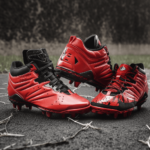As a parent, choosing the right football cleats for your child can be a daunting task. With so many different styles and features to consider, it can be overwhelming to know where to start. One of the most important factors to consider is the position your child plays on the field. Different positions require different types of cleats, each designed to enhance performance and reduce the risk of injury. In this guide, we’ll take a closer look at the specific needs of five different positions on the football field and recommend the best cleats for each. With this information, you can make an informed decision and help your child take their game to the next level.
For linemen, I recommend football cleats that have a high-top design with good ankle support. This is because linemen engage in a lot of physical contact and need to be able to hold their ground against other players. The high-top design helps to provide stability and support to the ankle and foot, which can help prevent injuries. Additionally, lineman cleats should have a strong and durable outsole that can withstand the wear and tear of the game.
 Running Back: Running backs require football cleats that provide good traction and allow for quick cuts and changes in direction. I recommend cleats that have a low-cut design, which allows for greater flexibility and maneuverability. Running back cleats should also have a lightweight construction and a comfortable fit to minimize fatigue during long games.
Running Back: Running backs require football cleats that provide good traction and allow for quick cuts and changes in direction. I recommend cleats that have a low-cut design, which allows for greater flexibility and maneuverability. Running back cleats should also have a lightweight construction and a comfortable fit to minimize fatigue during long games.
Receiver: Wide receivers need football cleats that provide excellent traction, speed, and maneuverability. Cleats with a low-cut design and a narrow fit are ideal for receivers as they allow for quick cuts and changes in direction. The cleats should also have a lightweight construction, and a snug fit to enhance agility and speed.
Linebacker: Linebackers require football cleats that provide good ankle support, as well as excellent traction and stability. Cleats with a mid-cut design can offer the best of both worlds, providing enough support to the ankle while still allowing for quick movement on the field. The cleats should have a durable outsole to withstand the physical contact that linebackers often encounter.
Quarterback: Quarterbacks require football cleats that allow for quick movement and good traction. Cleats with a low-cut design are ideal for quarterbacks as they provide the necessary flexibility and maneuverability. The cleats should also have a lightweight construction to minimize fatigue during long games and practices.
Overall, when choosing football cleats for your child, it’s important to consider the position they play and the specific needs that come with that position. By selecting the right type of cleat, you can help your child play more effectively and reduce the risk of injuries on the field.
